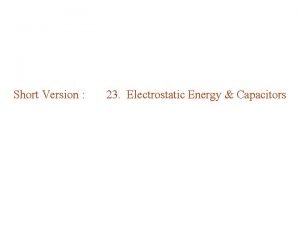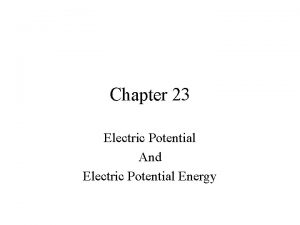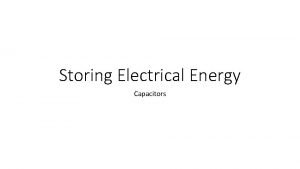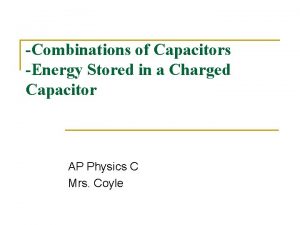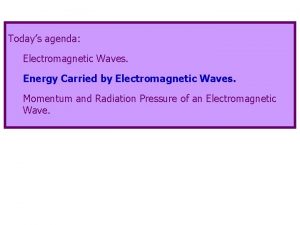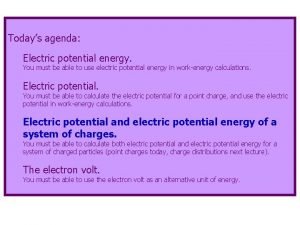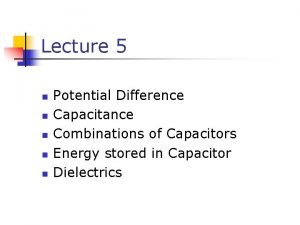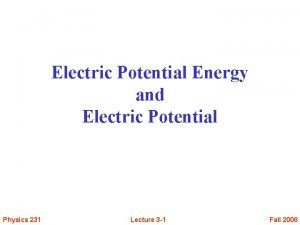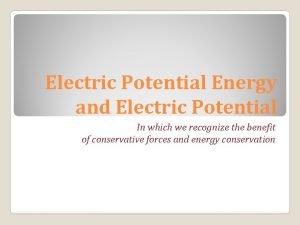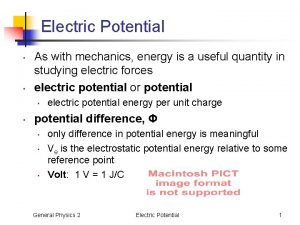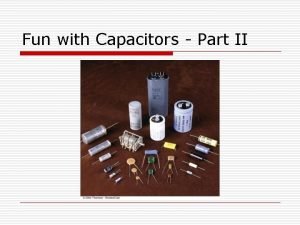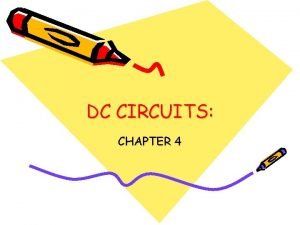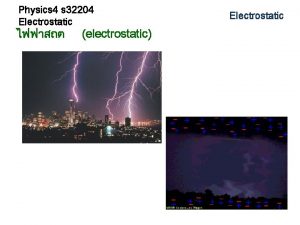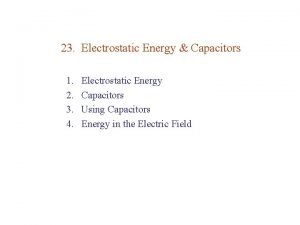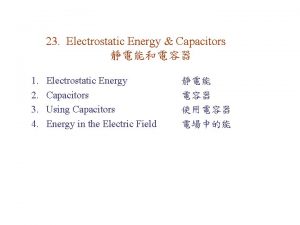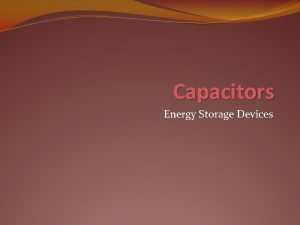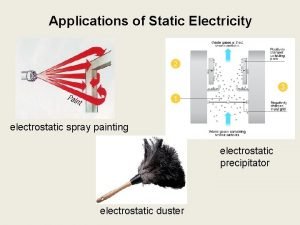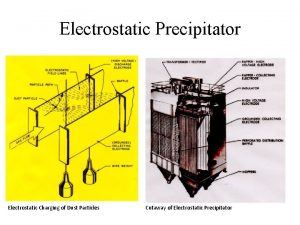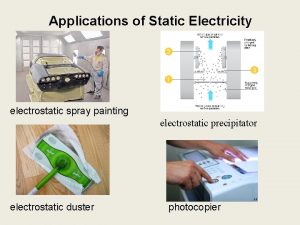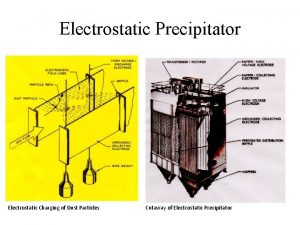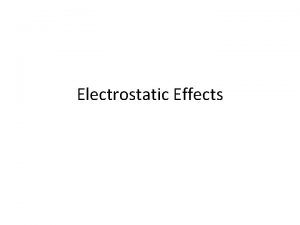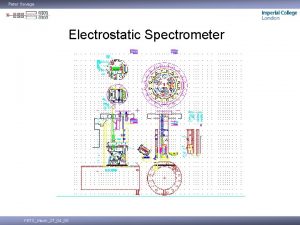Short Version 23 Electrostatic Energy Capacitors 23 1















- Slides: 15

Short Version : 23. Electrostatic Energy & Capacitors

23. 1. Electrostatic Energy = work done to assemble the charge configuration of a system. Reference ( 0 energy): when all component charges are widely separated. Bringing q 1 in place takes no work. Bringing in q 2 takes Bringing in q 3 takes Total electrostatic energy

23. 2. Capacitors Capacitor: pair of conductors carrying equal but opposite charges. Usage: store electrical energy Parallel-Plate Capacitor: 2 conducting plates of area A separated by a small distance d. Plates are initially neutral. They’re charged by connecting to a battery. Charge transfer plates are equal but oppositely charged. Large A, small d E 0 outside. Far from the edges

Capacitance Parallel-plate capacitor: C = Q / V = capacitance Parallel-plate capacitor See Probs 41 & 42 Practical capacitor ~ F ( 10 6 F) or p. F ( 10 12 F ) Charging / Discharging

Energy Stored in Capacitors When potential difference between capacitor plates is V, work required to move charge d. Q from to + plate is E dr < 0 Work required to charge the capacitor from 0 to V is = U = energy stored in capacitor Note: In a “charged” capacitor, Q is the charge on the + plate. The total charge of the capacitor is always zero.

Example 23. 1. Parallel-Plate Capacitor A capacitor consists of two circular metal plates of radius R = 12 cm, separated by d = 5. 0 mm. Find (a) Its capacitance, (b) the charge on the plates, and (c) the stored energy when the capacitor is connected to a 12 -V battery. (a) (b) (c)

Practical Capacitors Inexpensive capacitors: Thin plastic sandwiched between aluminum foils & rolled into cylinder. Electrolytic capacitors (large capacitance): Insulating layer developed by electrolysis. Capacitors in IC circuits (small capacitance): Alternating conductive & insulating layers.

Dielectrics: insulators containing molecular dipoles but no free charges. Molecular dipoles aligned by E 0. Dielectric layer lowers V between capacitor plates by factor 1/ ( > 1). = dielectric constant Dipole fields oppose E 0. Net field reduced to E = E 0 / . Hence V = V 0 / . Q is unchanged, so C = C 0.

: 2 ~ 10 mostly Working voltage V = Max safe potential < Ebkd d

Example 23. 2. Which Capacitor? A 100 - F capacitor has a working voltage of 20 V, while a 1. 0 - F capacitor is rated at 300 V. Which can store more charge? More energy?

Connecting Capacitors Two ways to connect 2 electronic components: parallel & series Parallel: Same V for both components Series: Same I (Q) for both components

Bursts of Power Capacitors deliver higher energy much more quickly than batteries. Flash light: Battery charges capacitor, which then discharges to give flash. San Francisco’s BART train: KE of deceleration stored as EE in ultracapacitor. Stored EE is used to accelerate train. Other examples: Defibrillator, controlled nuclear fusion, amusement park rides, hybrid cars, …

23. 4. Energy in the Electric Field Charging a capacitor rearranges charges energy stored in E Energy density = energy per unit volume Parallel-plate capacitor: Energy density : is universal

Example 23. 4. A Thunderstorm Typical electric fields in thunderstorms average around 105 V/m. Consider a cylindrical thundercloud with height 10 km and diameter 20 km, and assume a uniform electric field of 1 105 V/m. Find the electric energy contained in this storm. ~ 1400 gallons of gasoline.

Example 23. 5. A Shrinking Sphere A sphere of radius R 1 carries charge Q distributed uniformly over its surface. How much work does it take to compress the sphere to a smaller radius R 2 ? Work need be done to shrink sphere Extra energy stored here
 Tall+short h
Tall+short h C=q/v
C=q/v Energy stored in capacitors
Energy stored in capacitors Capacitor energy
Capacitor energy Potential energy of capacitor
Potential energy of capacitor Em wave energy density
Em wave energy density Electrostatic potential energy
Electrostatic potential energy Electric potential
Electric potential Electric potential from electric field
Electric potential from electric field A potential difference of 231
A potential difference of 231 Electric potential energy
Electric potential energy Volts to ev
Volts to ev Physics 2
Physics 2 Exposition of jack and the beanstalk
Exposition of jack and the beanstalk Fun with capacitors
Fun with capacitors Capacitors in dc circuits
Capacitors in dc circuits

